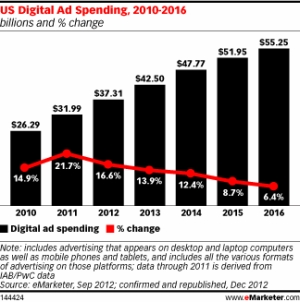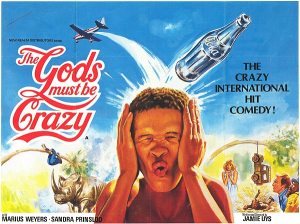PAYING TO BE FIRST IN LINE
Posted by Robbyn Brooks
Search ads and digital advertising continues to grow
Companies fork out billions upon billions of advertising dollars each year to make sure business stays on the upward climb. And to do that, there’s been a shift to digital advertising. That is a shift that’s only natural, considering that people spend more and more time on their computers and smartphones and less and less time in front of a printed newspaper or listening to the radio.
 According to an eMarketer article from 2012, Google, Yahoo!, Microsoft, Facebook and AOL were expected to take in just under $24 billion in advertising revenue that year. By 2014, Google’s growth was expected to see marketers spending more than $20 billion with $3 billion more going to other digital efforts. It’s also been reported that in 2012, Google made more in the first six months of the year (almost $21 billion) than all U.S. print media industry combined (just more than $19 billion).
According to an eMarketer article from 2012, Google, Yahoo!, Microsoft, Facebook and AOL were expected to take in just under $24 billion in advertising revenue that year. By 2014, Google’s growth was expected to see marketers spending more than $20 billion with $3 billion more going to other digital efforts. It’s also been reported that in 2012, Google made more in the first six months of the year (almost $21 billion) than all U.S. print media industry combined (just more than $19 billion).
Leading the pack in what companies are paying Google for are search ads. Those are the ads that look a whole lot like regular links that pop up after a Google search. They are highlighted in a very light pink color, so to the Internet unsavvy, it’s hard to distinguish those ads from news and organization links that aren’t paid for. The way it works is, companies pay to have their links come in in searches for words. For instance, if you search for the keyterm “pools,” pool companies that pay Google will come up above all other listings. Seems like a great way to market a product, right? It’s a sure fire way to always make sure your name comes up on top. The downside is, those search ads can be used to deceive the public too.
 In 2010, BP paid to have its website rank higher on search results to bolster the company’s image. They bought into search terms such as “oil spill,” “volunteer,” and “claims.” BP wouldn’t say how much they paid for the service, but they spent more than $50 million on television ads to make themselves look better. Google doesn’t permit news sites and blogs to promote with search ads, so if a person was looking for unbiased reporting on the oil spill in the Gulf of Mexico, they would first have to make it beyond the BP controlled ads that linked to the company’s “Gulf of Mexico Response” page filled with videos and articles explaining how BP was resolving the issue. The use of the search ads was highly publicized and consumers admitted they felt tricked by BP. BP could have probably better used those millions of dollars to pay claims and perform actual clean-up to get back in the good graces of the country instead.
In 2010, BP paid to have its website rank higher on search results to bolster the company’s image. They bought into search terms such as “oil spill,” “volunteer,” and “claims.” BP wouldn’t say how much they paid for the service, but they spent more than $50 million on television ads to make themselves look better. Google doesn’t permit news sites and blogs to promote with search ads, so if a person was looking for unbiased reporting on the oil spill in the Gulf of Mexico, they would first have to make it beyond the BP controlled ads that linked to the company’s “Gulf of Mexico Response” page filled with videos and articles explaining how BP was resolving the issue. The use of the search ads was highly publicized and consumers admitted they felt tricked by BP. BP could have probably better used those millions of dollars to pay claims and perform actual clean-up to get back in the good graces of the country instead.
But hold on, Google, you may be raking in the money now, but someone is looking to take your place. Bing just keeps plugging away at an effort to make the company as popular as Google. Recently, Microsoft has paid for Bing to appear in the movie Source Code and the television show The Vampire Diaries. The company even ran an ad during the popular AMC show The Walking Dead after efforts to have Bing inserted in the show failed. The biggest call out Bing received for product placement, however, was with its use in The Amazing Spiderman when Peter Parker uses Bing as a search engine. Nerds united saying that a nerd like Peter Parker would never use Bing. However, the company’s efforts might be paying off. Bing has garnered about 30 percent of the search market when taking into consideration that Yahoo! is Bing powered.
In addition to search ads, companies can place digital advertisements on news websites, social media sites, blogs and other online locations and applications. But where those ads are placed and what they look like bakes a big difference as to whether or not the message is seen by consumers. The Poynter Institute’s Eye Tracking Study is a good read for marketers looking to get the most bang for their buck online. Pointer found out that Net surfers spend a lot of time looking at the top left of pages and in the upper section as a whole before moving down and to the right. That’s because normal initial eye movement focuses around the upper left part of the screen. The Poynter study indicated that ads work better in the left hand column instead of the right hand column because the right side of the page is an “after thought.” Also, text ads were viewed the most closely of all the ones Poynter looked at. They are less distracting and camouflage well with other page content. Bigger ads have a better chance of being seen and the bigger an image, the more time people take to survey it.
 Digressing a little bit from digital advertising (because this is my blog and I can if I want to) to the importance of viewing repetition and it’s importance to branding, when I was looking at Bing’s efforts with product placement, I began to think about companies who use it well. My husband and I were just at a movie last night and there’s no doubt that Coca-Cola has the market on movie product placement. The company believes that repetition and and brand association goes a long way in the minds of consumers, and judging by how much they spend at the movies, they must be right. Over the last 80 years, Coke products have been in iconic films such as It’s a Wonderful Life, King Kong, The Exorcist, E.T., Jaws, Batman, Independence Day, The Gods Must Be Crazy and many others. AnyClip used tagging technology to try and pinpoint how much time Coke products received on camera over the years. (There’s a pretty nifty infographic at the link.) AnyClip found that there was a relationship between a film’s budget and the amount of time Coke products appeared on screen in a movie. Of all the time spent on screen Coke products appeared 32 percent in cans, 20 percent on signs, 18 percent in bottles, 12 percent in glasses, 7 percent in cups and 11 percent “other.” Coke’s brand influence in movies is 9.7, Apple is at 9.1 and Toyota comes in at 7.5.
Digressing a little bit from digital advertising (because this is my blog and I can if I want to) to the importance of viewing repetition and it’s importance to branding, when I was looking at Bing’s efforts with product placement, I began to think about companies who use it well. My husband and I were just at a movie last night and there’s no doubt that Coca-Cola has the market on movie product placement. The company believes that repetition and and brand association goes a long way in the minds of consumers, and judging by how much they spend at the movies, they must be right. Over the last 80 years, Coke products have been in iconic films such as It’s a Wonderful Life, King Kong, The Exorcist, E.T., Jaws, Batman, Independence Day, The Gods Must Be Crazy and many others. AnyClip used tagging technology to try and pinpoint how much time Coke products received on camera over the years. (There’s a pretty nifty infographic at the link.) AnyClip found that there was a relationship between a film’s budget and the amount of time Coke products appeared on screen in a movie. Of all the time spent on screen Coke products appeared 32 percent in cans, 20 percent on signs, 18 percent in bottles, 12 percent in glasses, 7 percent in cups and 11 percent “other.” Coke’s brand influence in movies is 9.7, Apple is at 9.1 and Toyota comes in at 7.5.
Posted on July 6, 2013, in Journalism, New Media, Public Relations, Social Media, Strategic Communications, Technology and tagged AnyClip, Apple, Bing, BP, Coca-Cola, google, Google Search, Microsoft, oil spill, Poynter Institute, product placement, search ads, Vampire Diaries, Yahoo. Bookmark the permalink. 2 Comments.
I find it funny that “search engines” are now competing for product recognition. in the words of the young kids- That’s so meta! To think that the main sources of digital ad revenue are themselves fighting and clawing for face time just blows my mind. Sometimes product placement is subtle and sometimes it is right in your face. I had not thought about Bing showing up in Spiderman until you mentioned it so maybe they did a good job in sneaking it in. The eye tracking data makes sense to me. Seeing that we start reading from the left. It only makes sense that we like to start from the very beginning. I hear that’s a very good place to start. However I wonder if the same data applies in “eastern” countries where most of their writing goes from right to left or even up and down in the case of some Asian nations. All in all I think it is going to be interesting to see how the world of digital ads changes in the coming years. Also “The Gods Must Be Crazy” is one of the greatest movies of all time!!!
I forget that there are people who probably don’t know that the first two or so links that pop up in that little pink box on Google are actually advertisements. I almost never even look to see what those links are, and instead, completely ignore them and move to the first to pop up in actual results. For people like me, buying Google search ads is pointless.